William Shakespeare (1552 to 1616) was undoubtedly our greatest playwright and poet. He lived until the age of fifty-two and although he was born and is buried in Stratford-upon-Avon, it was in London that he made his fame and fortune. His plays are regularly revived on the London stage, and the Globe Theatre, where he made his reputation as a playwright, was rebuilt in the late twentieth century largely as a result of the efforts of the American actor and theatre director Sam Wanamaker. 401 years on from the publication of the First Folio of his plays in 1623, the ‘Swan of Avon’ remains one of Britain’s greatest gifts to the world, with his plays having been translated into over a hundred languages.
Known as The Bard of Avon, Shakespeare remains a powerful draw for overseas visitors to London and Stratford-Upon-Avon, which welcomes over six million visitors a year. However, it is possible to see and learn a great deal about Shakespeare by staying in London and, indeed, without leaving the great treasure house of the Victoria & Albert Museum! Let me take you on a whistle-stop tour of Shakespeare in SW7.
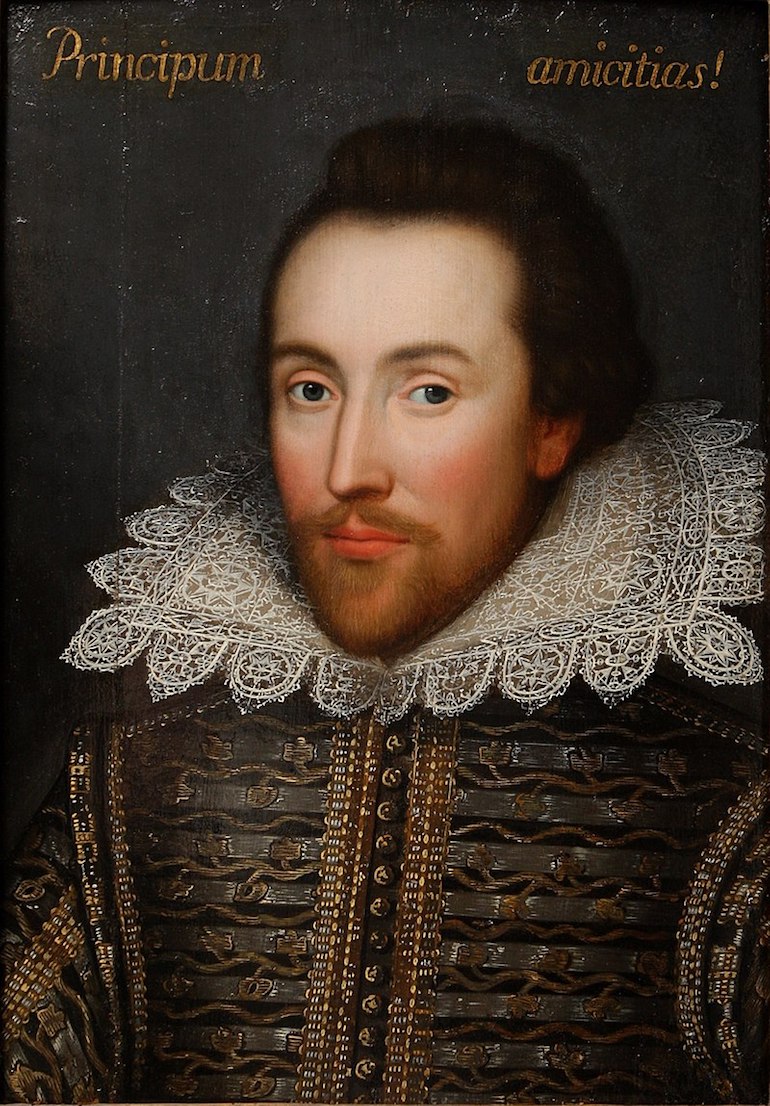 William Shakespeare portrait known as the Cobbe painting. Photo Credit: © Public Domain via Wikimedia Commons.
William Shakespeare portrait known as the Cobbe painting. Photo Credit: © Public Domain via Wikimedia Commons.
Shakespeare at the Victoria & Albert Museum
We enter the Victoria & Albert Museum by the Cromwell Road doors and east of the Grand Entrance. At the base of stairs to Room 52, opposite the cloakroom, we encounter a marble statue of fairy prankster Puck. This 1860 work is by John Lough, a specialist in works based on characters and themes in Shakespeare’s plays. The museum owns other works by Lough, including marbles of Titania, also from A Midsummer Night’s Dream, Jaques from As You Like It and a bronze from Macbeth depicting Duncan’s horses eating one another.
From here, we move to the British Galleries, where we can see the man himself in Room 52. A 1726 bust by Michael Rysbrack, the Flemish sculptor responsible for many monuments in Westminster Abbey stands here. It is a version of a later Rybrack bust in the Temple of British Worthies at Stowe and may have been a model for it.
Shakespeare’s contributions to the English language are myriad, and we can see an early example on a beaded bag in Room 56. This rare survival from the 1630s, with its stylized floral patterns and inexpensive materials imitates the elaborate versions carried by the aristocracy. Many of these bags bore phrases relating to charity, friendship, or luck and this one is inscribed ‘heare et is hit or miss’; hit or miss’ being first recorded in English in 1606’s Troilus and Cressida, where it has the same meaning of random luck that it has today.
Topical references pepper the plays and one such is to the Great Bed of Ware which dominates Room 57. Flamboyantly carved, over three metres wide and reputedly able to accommodate four couples, it was probably made as a tourist attraction for an inn at Ware, north of London. Its reputation quickly reached Shakespeare who refers to it in 1602’s Twelfth Night, when Sir Toby Belch advises Andrew Aguecheek to write “as many lies as will lie in thy sheet of paper, although the sheet were big enough for the bed of Ware.’
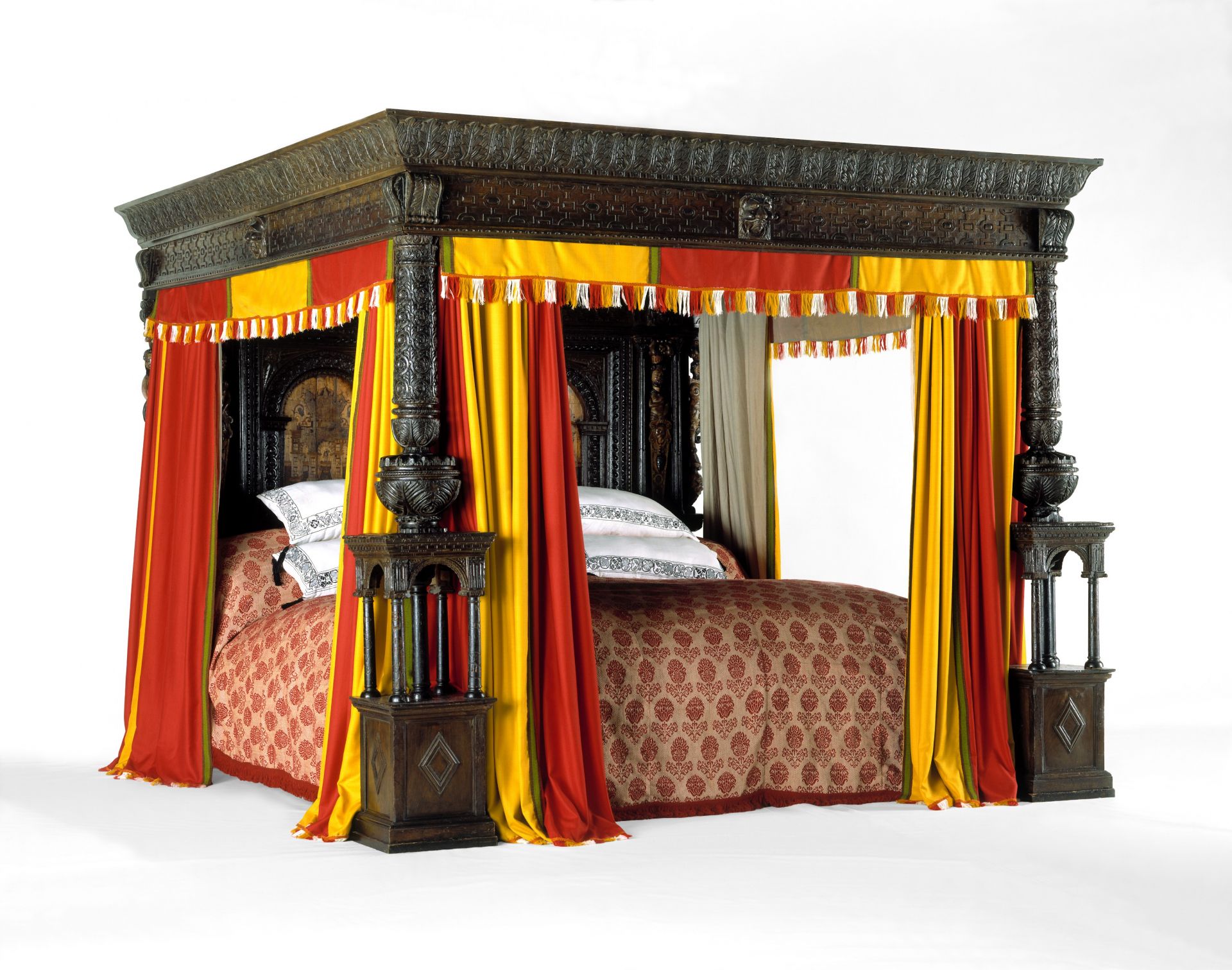 Victoria & Albert Museum _ ‘The Great Bed of Ware’, carved oak bed, probably from Ware, Hertfordshire, UK, about 1590. Photo Credit: ©Victoria & Albert Museum
Victoria & Albert Museum _ ‘The Great Bed of Ware’, carved oak bed, probably from Ware, Hertfordshire, UK, about 1590. Photo Credit: ©Victoria & Albert Museum
Another item of woodwork follows in Room 120. Shakespeare has always been a nice little earner, and the elaborate tea caddy of 1759, bearing a representation of Shakespeare’s monument in Holy Trinity Church, Stratford, is a souvenir said to have been made from the wood of a mulberry tree in his Stratford garden. The tree became a focus of literary pilgrimage in the eighteenth century; the then-owner of the house became so enraged at the invasion of his privacy that he cut it down – and a cottage industry in small souvenirs made of its wood was born. The number of souvenirs far outweighed the wood in the original tree, so it is more than possible that other, less-famed, mulberry trees were felled to meet the demand!
Also in Room 120 is an embroidered and painted eighteenth-century silk picture showing Fame placing a wreath on Shakespeare’s tomb. Copied from a print by Francesco Bartolozzi, itself based on a painting by Angelica Kauffmann, the subject was intended both as a tribute to Shakespeare’s fame and as a fashionable expression of romantic sorrow and was the first of several subjects for embroideries in Britain.
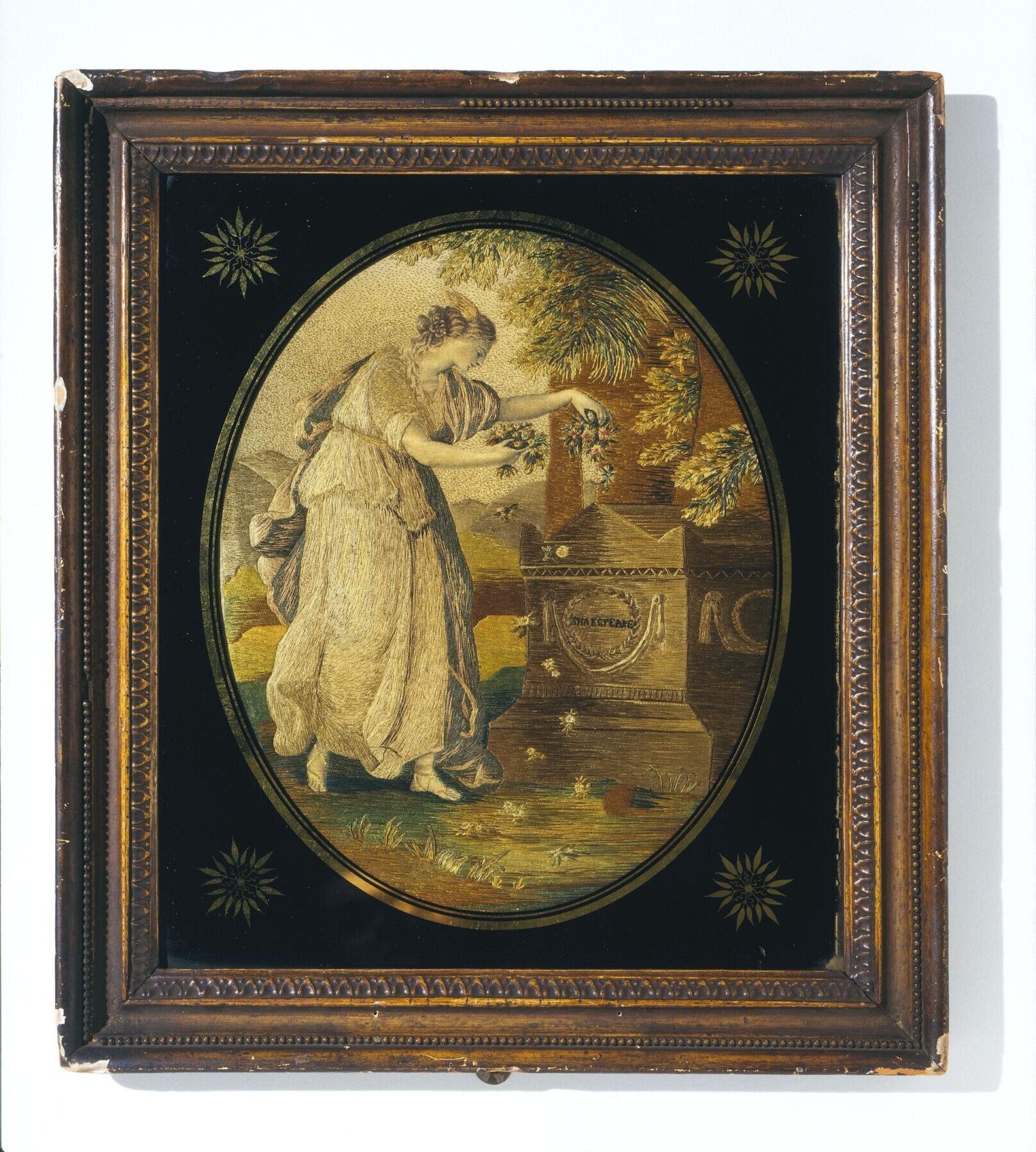 Fame at the tomb of Shakespeare. Photo Credit: © Victoria & Albert Museum, London.
Fame at the tomb of Shakespeare. Photo Credit: © Victoria & Albert Museum, London.
Other images in the same room include (in a drawer) a watercolour of 1790 by Francis Wheatley, showing the Prince of Wales’s visit to the Shakespeare Gallery in Pall Mall, where Wheatley’s patron, printmaker and seller John Boydell sold engravings of a series of oil paintings representing scenes from Shakespeare’s plays which he commissioned from famous artists of the time.
There is also an oil painting of Queen Katherine and Patience painted in 1842 by Charles Robert Leslie RA. There was a revival of interest in Shakespeare at that time and artists exhibited paintings illustrating scenes from the plays; Leslie depicts a scene from Henry VIII, showing Katherine of Aragon in melancholy mood because of the King’s growing estrangement.
Moving to the Ceramics Galleries, London Blue Badge Tourist Guides will readily recognise the porcelain figure of Shakespeare leaning on a pedestal by William Duesbury & Co. of Derby. Dating from around 1800, it is a copy of the 1740 monument in Westminster Abbey, designed by William Kent.
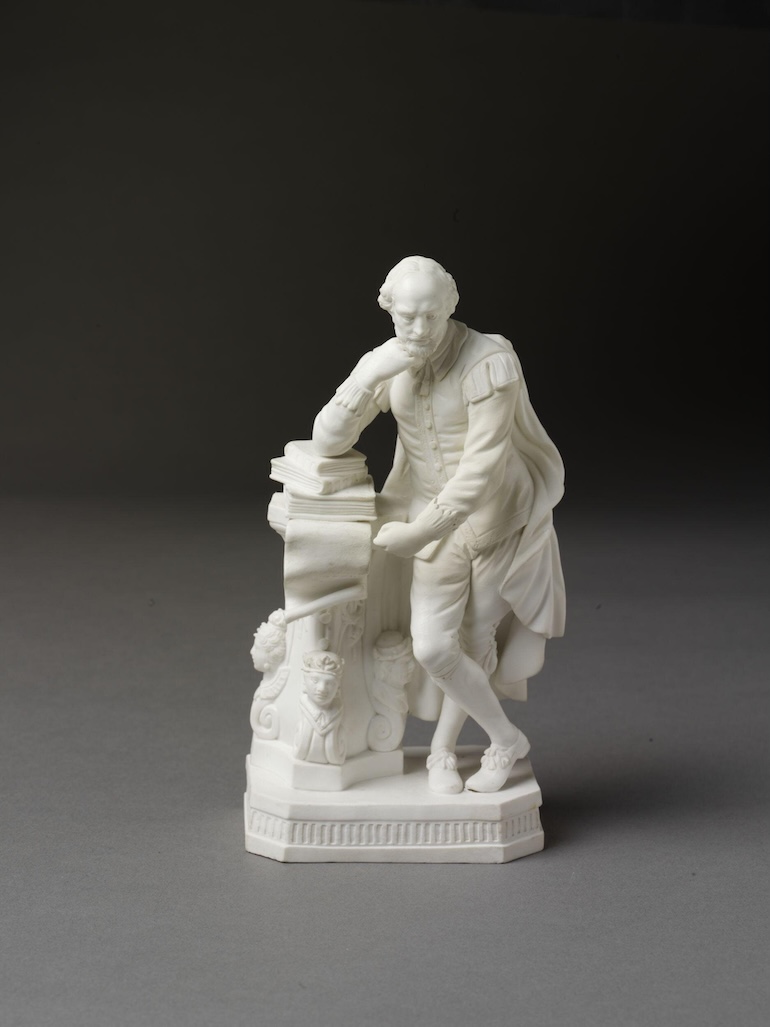 Figure of Shakespeare in biscuit soft-paste porcelain. Photo Credit: © Victoria & Albert Museum.
Figure of Shakespeare in biscuit soft-paste porcelain. Photo Credit: © Victoria & Albert Museum.
Art inspired by Shakespeare’s characters is not all centuries old: coming up-to-date in Room 91 in the Jewellery Gallery, the 1985 ring by the British artist Kevin Coates depicts the head of Caliban, the half-human, half-monster character from 1611’s The Tempest. Coates’s work often draws upon literary and mythological sources: here a storm-grey moonstone forms Caliban’s head, with rubies for his eyes, his arms crossed with the bindings of his enslavement by Prospero and his hands forming a golden shank clutching the skull.
More characters can be seen in the Paintings Gallery, in Room 82, where Thomas Stothard’s 1812 oil, Shakespeare’s Principal Characters, shows some key players from Twelfth Night, As You Like It, The Tempest, King Lear, Hamlet and Macbeth and in the Sculpture Gallery where four plaster models for two stone friezes can be found in Room 22. Commissioned by sculptor John Flaxman in 1809 by the architect Robert Smirke, the friezes represented Ancient and Modern Drama, respectively and were probably the first examples of the direct influence of the Parthenon marbles, which Flaxman saw in 1807 when they were brought to England by Lord Elgin. This model illustrates one-half of Modern Drama and shows Shakespeare seated on the right, with figures from The Tempest and Macbeth.



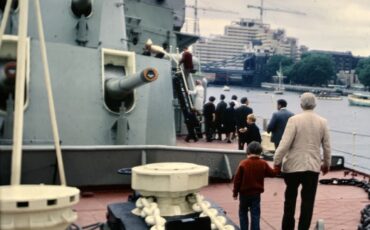



Leave a Reply